Response of Different Band Combinations in Gaofen-6 WFV for Estimating of Regional Maize Straw Resources Based on Random Forest Classification
Abstract
1. Introduction
2. Materials and Methods
2.1. Research Area
2.2. Data Source and Preprocessing
2.3. Classification of Land Cover Types Using Different Bands Combinations
2.4. Classes Separability Assessment
2.5. Maize Straw Estimation
2.6. Accuracy Verification
3. Results and Discussion
3.1. Band Reflectivity Analysis
3.2. Class Separability
3.3. Maize Identification and Classification Results
3.4. Spatial Distribution of Maize Straw
4. Conclusions
- Both SVM and RF models can effectively identify and aid in the classification of land cover types in the research area. The RF model exhibits improved classification accuracy compared to that of SVM when the newly added band of GF-6 WFV was used;
- The addition of two red-edge bands increased the separability of land cover types with large differences in red-side spectral characteristics and generally significantly improved the overall classification accuracy and reduced the misclassification and omission of crops. Red-edge 1 can improve the recognition accuracy of land cover types more than Red-edge 2 in Qihe County. In this study, the classification accuracy and KC of the RF model increased from 85.57% and 0.82 to 93.15% and 0.91, respectively, after adding two red-edge bands;
- The response of purple and yellow bands to non-vegetation was more obvious than that to vegetation, which increased the classification accuracy of non-vegetation and slightly reduced the “salt-and-pepper noise” in the classification results. However, the effects of the two bands on the classification accuracy of vegetation and the total classification accuracy were not obvious;
- The theoretical total quantity of maize straw in Qihe County was 586.08 kt in 2018, which reflected only a 2.42% error from the statistical result. Maize straw in Qihe County was planted, excluding in central and northern urban areas. Among them, the southern and northeastern regions exhibited the widest distribution areas and highest average densities, followed by the northernmost and southernmost regions. The central and northern urban areas exhibited the lowest average distribution densities.
5. Future Work
Author Contributions
Funding
Institutional Review Board Statement
Informed Consent Statement
Data Availability Statement
Acknowledgments
Conflicts of Interest
References
- Jiao, X.; Mongol, N.; Zhang, F. The transformation of agriculture in China: Looking back and looking forward. J. Integr. Agric. 2018, 17, 755–764. [Google Scholar] [CrossRef]
- El-Dewany, C.; Awad, F.; Zaghloul, A.M. Utilization of rice straw as a low-cost natural by-product in agriculture. Int. J. Environ. Pollut. Environ. Model. 2018, 1, 91–102. [Google Scholar]
- Nie, P.; Sousa-Poza, A.; Xue, J. Fuel for life: Domestic cooking fuels and women’s health in rural China. Int. J. Environ. Res. Public Health 2016, 13, 810. [Google Scholar] [CrossRef]
- Cui, M.; Zhao, L.; Tian, Y.; Meng, H.; Sun, L.; Zhang, Y.; Wang, F.; Li, B. Analysis and evaluation on energy utilization of main crop straw resources in China. Trans. Chin. Soc. Agric. Eng. 2008, 24, 291–296. (In Chinese) [Google Scholar]
- Wang, Y.; Bi, Y.; Gao, C. The assessment and utilization of straw resources in China. Agric. Sci. China 2010, 9, 1807–1815. [Google Scholar] [CrossRef]
- Ren, J.; Yu, P.; Xu, X. Straw utilization in China—Status and recommendations. Sustainability 2019, 11, 1762. [Google Scholar] [CrossRef]
- Hong, J.; Ren, L.; Hong, J.; Xu, C. Environmental impact assessment of corn straw utilization in China. J. Clean. Prod. 2016, 112, 1700–1708. [Google Scholar] [CrossRef]
- Wang, B.; Shen, X.; Chen, S.; Bai, Y.; Yang, G.; Zhu, J.; Shu, J.; Xue, Z. Distribution characteristics, resource utilization and popularizing demonstration of crop straw in southwest China: A comprehensive evaluation. Ecol. Indic. 2018, 93, 998–1004. [Google Scholar] [CrossRef]
- Abdel-Mohdy, F.A.; Abdel-Halim, E.S.; Abu-Ayana, Y.M.; El-Sawy, S.M. Rice straw as a new resource for some beneficial uses. Carbohyd. Polym. 2009, 75, 44–51. [Google Scholar] [CrossRef]
- Venturini, G.; Pizarro-Alonso, A.; Münster, M. How to maximise the value of residual biomass resources: The case of straw in Denmark. Appl. Energy 2019, 250, 369–388. [Google Scholar] [CrossRef]
- Bi, Y.Y.; Wang, Y.J.; Gao, C.Y. Straw Resource quantity and its regional distribution in China. J. Agric. Mech. Res. 2010, 3, 1–7. [Google Scholar]
- Long, H.; Li, X.; Wang, H.; Jia, J. Biomass resources and their bioenergy potential estimation: A review. Renew. Sust. Energy Rev. 2013, 26, 344–352. [Google Scholar] [CrossRef]
- Moxey, A.; Mcclean, C.J.; Allanson, P. Transforming the spatial basis of agricultural census cover data. Soil Use Manag. 2010, 11, 21–25. [Google Scholar] [CrossRef]
- Galanopoulos, C.; Odierna, A.; Barletta, D.; Zondervan, E. Design of a wheat straw supply chain network in Lower Saxony, Germany through optimization. Comput. Aided Chem. Eng. 2017, 40, 871–876. [Google Scholar]
- Zhou, L.; Gu, W.; Zhang, Q. Logistics mode and network planning for recycle of crop straw resources. Asian Agric. Res. 2013, 5, 87. [Google Scholar]
- Ballesteros, R.; Ortega, J.F.; Hernandez, D.; Del Campo, A.; Moreno, M.A. Combined use of agro-climatic and very high-resolution remote sensing information for crop monitoring. Int. J. Appl. Earth Obs. Geoinf. 2018, 72, 66–75. [Google Scholar] [CrossRef]
- Kern, A.; Barcza, Z.; Marjanović, H.; Árendás, T.; Fodor, N.; Bónis, P.; Bognár, P.; Lichtenberger, J. Statistical modelling of crop yield in Central Europe using climate data and remote sensing vegetation indices. Agric. For. Meteorol. 2018, 260, 300–320. [Google Scholar] [CrossRef]
- Atzberger, C. Advances in remote sensing of agriculture: Context description, existing operational monitoring systems and major information needs. Remote Sens. 2013, 5, 949–981. [Google Scholar] [CrossRef]
- Duveiller, G.; Defourny, P. A conceptual framework to define the spatial resolution requirements for agricultural monitoring using remote sensing. Remote Sens. Environ. 2010, 114, 2637–2650. [Google Scholar] [CrossRef]
- Vrieling, A.; Skidmore, A.K.; Wang, T.; Meroni, M.; Ens, B.J.; Oosterbeek, K.; O’Connor, B.; Darvishzadeh, R.; Heurich, M.; Shepherd, A. Spatially detailed retrievals of spring phenology from single-season high-resolution image time series. Int. J. Appl. Earth Obs. Geoinf. 2017, 59, 19–30. [Google Scholar] [CrossRef]
- Wang, L.; Liu, J.; Yang, F.; Yao, B.; Shao, J.; Yang, L. Rice recognition ability basing on GF-1 multi-temporal phases combined with near infrared data. Trans. Chin. Soc. Agric. Eng. 2017, 33, 196–202. (In Chinese) [Google Scholar]
- Li, S.; Zhao, J.; Dong, S.; Zhao, M.; Li, C.; Cui, Y.; Liu, Y.; Gao, J.; Xue, J.; Wang, L. Advances and prospects of maize cultivation in China. Sci. Agric. Sin. 2017, 50, 1941–1959. [Google Scholar]
- Xu, W. A LM-2D Launches GF-6 Satellite. Aerosp. China 2019, 19, 60. [Google Scholar]
- Tong, X.; Zhao, W.; Xing, J.; Fu, W. In Status and development of china high-resolution earth observation system and application. In Proceedings of the 2016 IEEE International Geoscience and Remote Sensing Symposium (IGARSS), Beijing, China, 10–15 July 2016; pp. 3738–3741. [Google Scholar]
- Young, N.E.; Anderson, R.S.; Chignell, S.M.; Vorster, A.G.; Lawrence, R.; Evangelista, P.H. A survival guide to Landsat preprocessing. Ecology 2017, 98, 920–932. [Google Scholar] [CrossRef]
- Lantzanakis, G.; Mitraka, Z.; Chrysoulakis, N. Comparison of physically and image based atmospheric correction methods for Sentinel-2 satellite imagery. In Perspectives on Atmospheric Sciences; Bais, A., Nastos, P., Eds.; Springer International Publishing: Cham, Switzerland, 2017; pp. 255–261. [Google Scholar]
- Mountrakis, G.; Im, J.; Ogole, C. Support vector machines in remote sensing: A review. ISPRS J. Photogramm. Remote Sens. 2011, 66, 247–259. [Google Scholar] [CrossRef]
- Breiman, L. Random forests. Mach. Learn. 2001, 45, 5–32. [Google Scholar] [CrossRef]
- Thanh Noi, P.; Kappas, M. Comparison of random forest, k-nearest neighbor, and support vector machine classifiers for land cover classification using Sentinel-2 imagery. Sensors 2018, 18, 18. [Google Scholar] [CrossRef]
- Du, P.; Xia, J.; Chanussot, J.; He, X. Hyperspectral remote sensing image classification based on the integration of support vector machine and random forest. In Proceedings of the 2012 IEEE International Geoscience and Remote Sensing Symposium, Munich, Germany, 22–27 July 2012; pp. 174–177. [Google Scholar]
- Van der Linden, S.; Rabe, A.; Held, M.; Jakimow, B.; Leitão, P.J.; Okujeni, A.; Schwieder, M.; Suess, S.; Hostert, P. The EnMAP-Box—A Toolbox and Application Programming Interface for EnMAP Data Processing. Remote Sens. 2015, 7, 11249–11266. [Google Scholar] [CrossRef]
- Gambarova, Y.M.; Gambarov, A.Y.; Rustamov, R.B.; Zeynalova, M.H. Remote sensing and GIS as an advance space technologies for rare vegetation monitoring in Gobustan State National Park, Azerbaijan. J. Geogr. Inf. Syst. 2010, 2, 93. [Google Scholar] [CrossRef][Green Version]
- Weiser, C.; Zeller, V.; Reinicke, F.; Wagner, B.; Majer, S.; Vetter, A.; Thraen, D. Integrated assessment of sustainable cereal straw potential and different straw-based energy applications in Germany. Appl. Energy 2014, 114, 749–762. [Google Scholar] [CrossRef]
- Tharwat, A. Classification assessment methods. Appl. Comput. Inform. 2020, 17, 168–192. [Google Scholar] [CrossRef]
- Ai, B.; Sheng, Z.; Zheng, L.; Shang, W. Collectable amounts of straw resources and their distribution in China. In Advances in Engineering Research, Proceedings of the International Conference on Advances in Energy, Environment and Chemical Engineering, Changsha, China, 26–27 September 2015; Atlantis Press: Paris, France, 2015; pp. 441–444. [Google Scholar]
- Jawak, S.D.; Luis, A.J. Improved land cover mapping using high resolution multiangle 8-band WorldView-2 satellite remote sensing data. J. Appl. Remote Sens. 2013, 7, 73573. [Google Scholar] [CrossRef]
- Martinez, L.J.; Ramos, A. Estimation of chlorophyll concentration in maize using spectral reflectance. Int. Arch. Photogramm. Remote Sens. Spat. Inf. Sci. 2015, 40, 65. [Google Scholar] [CrossRef]
- Löw, F.; Duveiller, G. Defining the spatial resolution requirements for crop identification using optical remote sensing. Remote Sens. 2014, 6, 9034–9063. [Google Scholar] [CrossRef]
- Kempeneers, P.; Sedano, F.; Seebach, L.; Strobl, P.; San-Miguel-Ayanz, J. Data fusion of different spatial resolution remote sensing images applied to forest-type mapping. IEEE Trans. Geosci. Remote Sens. 2011, 49, 4977–4986. [Google Scholar] [CrossRef]
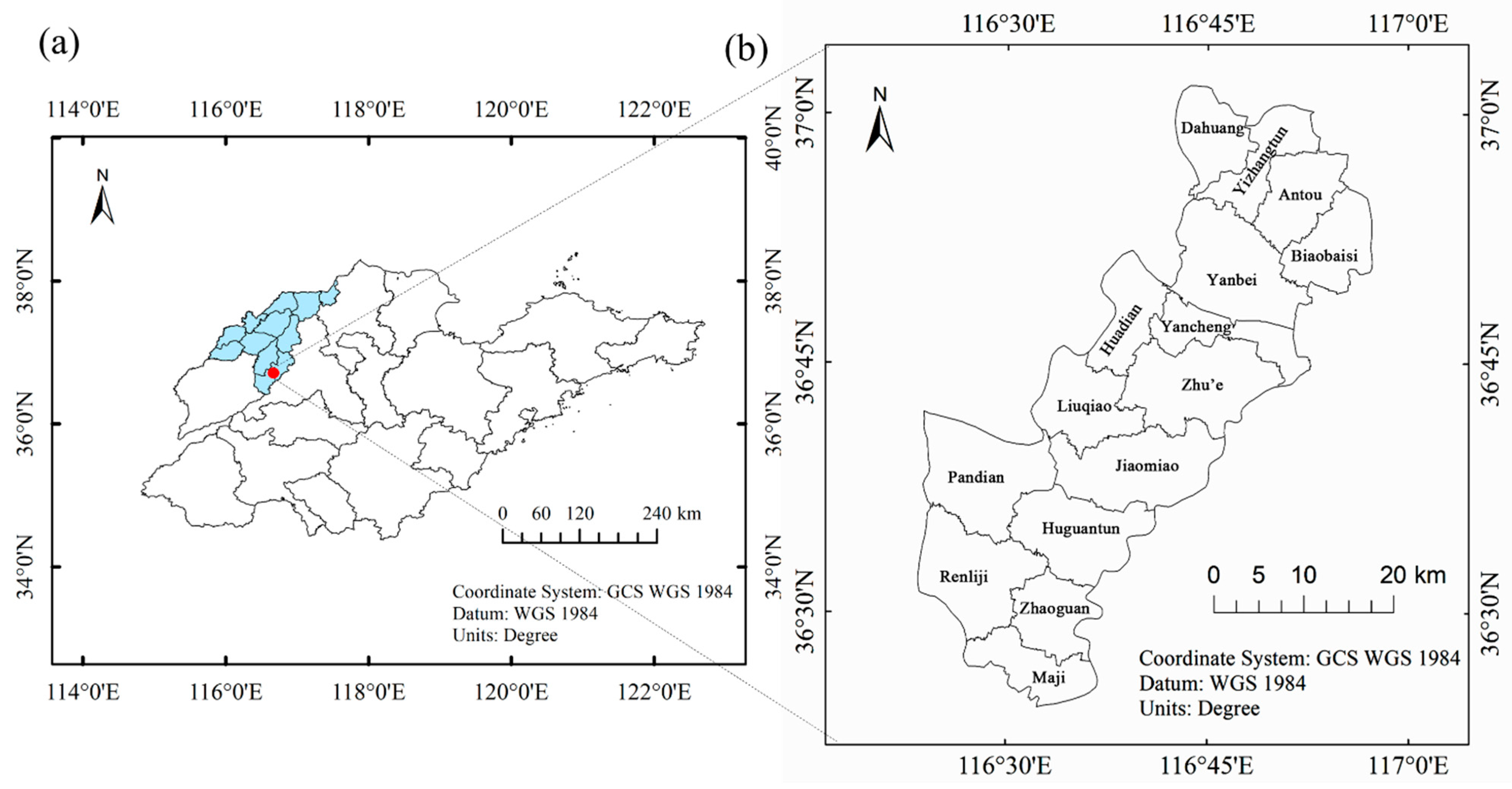

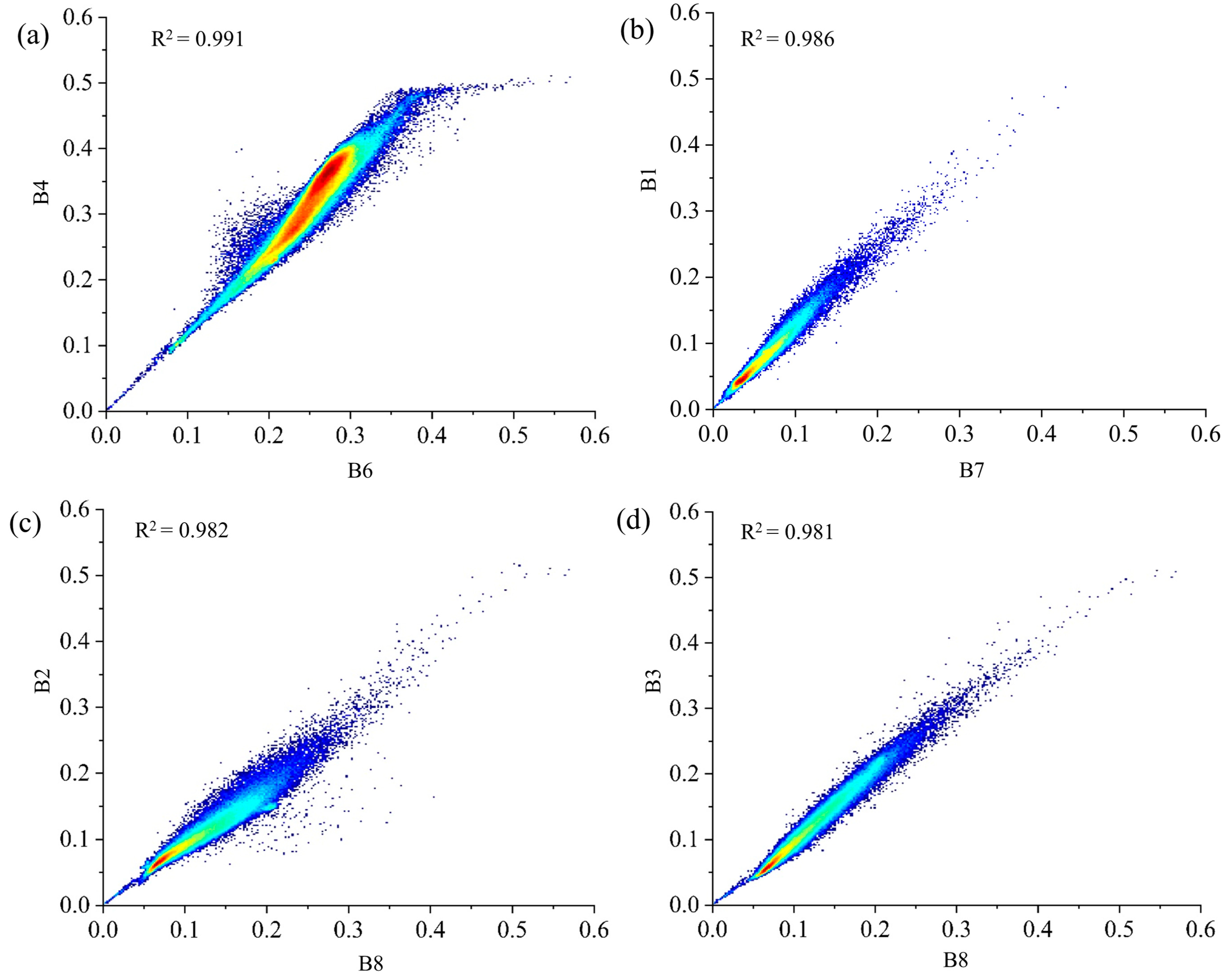
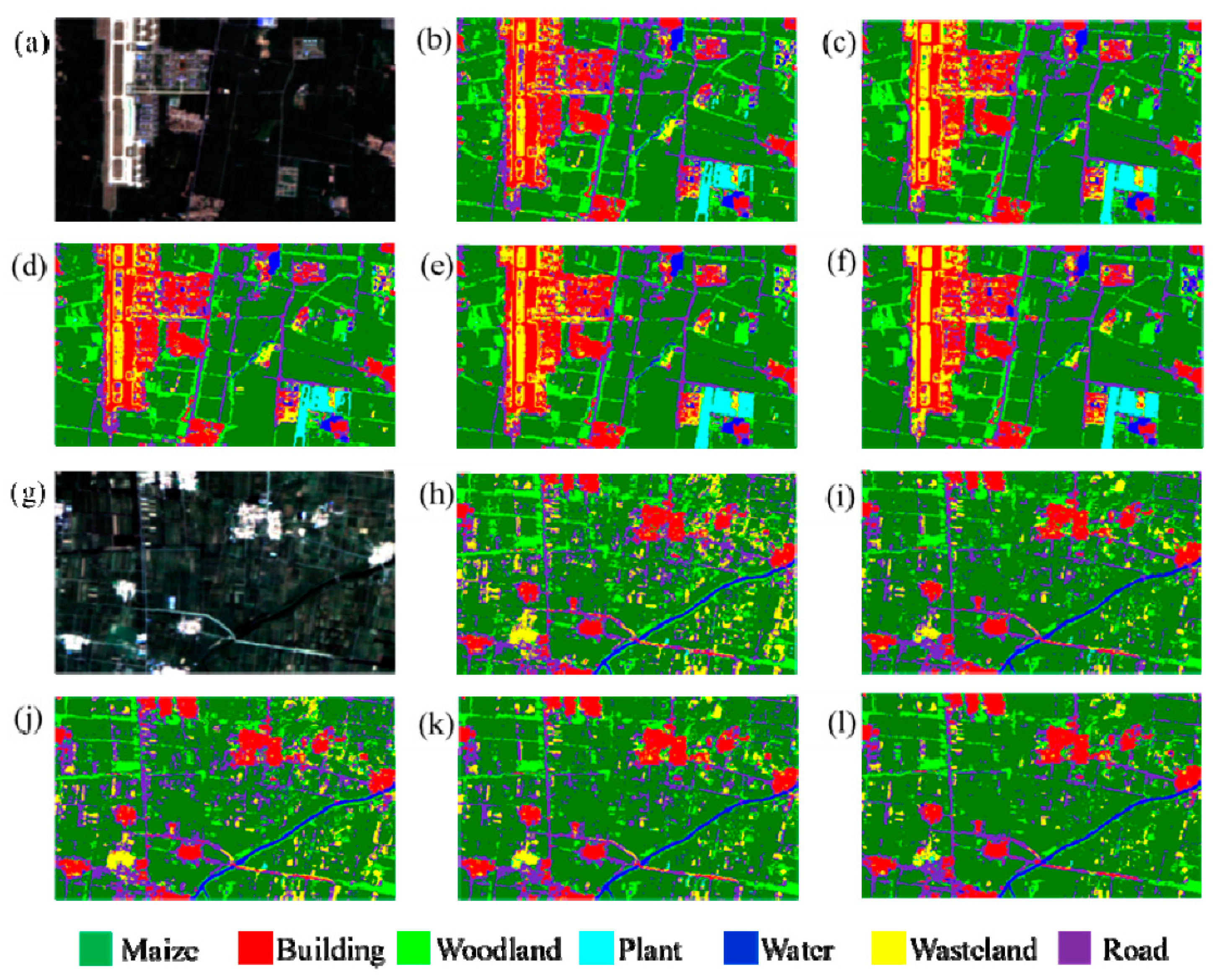
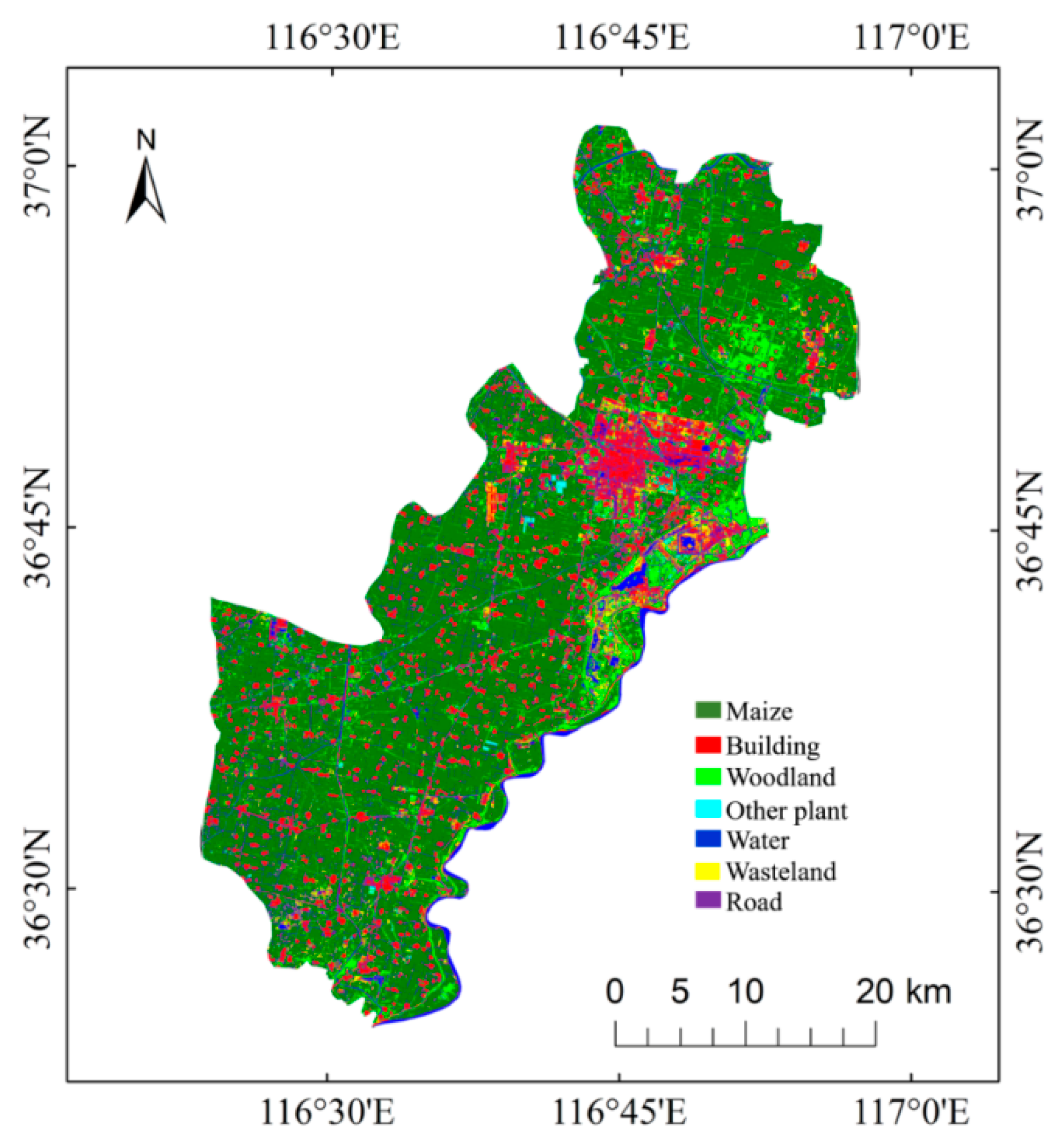
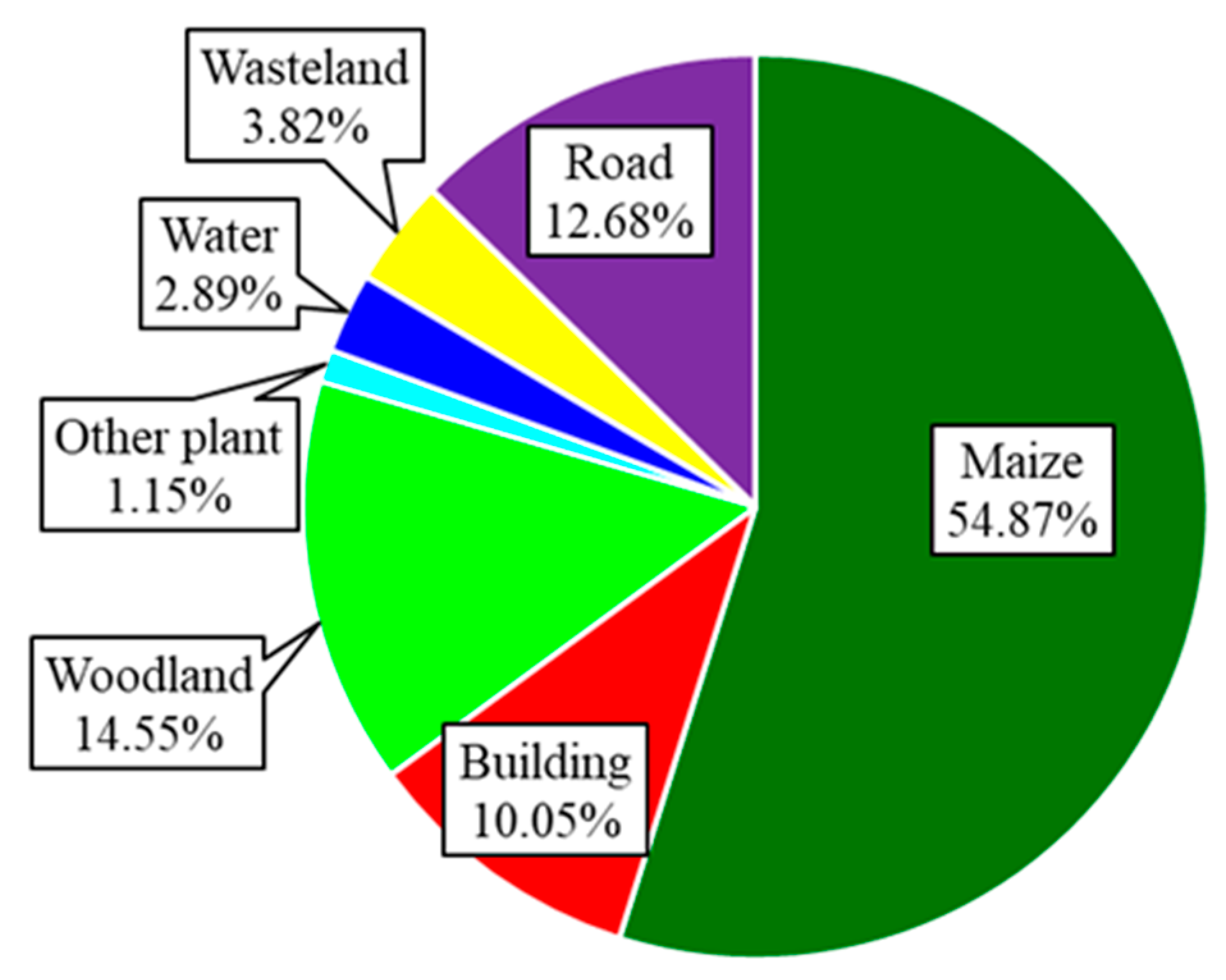
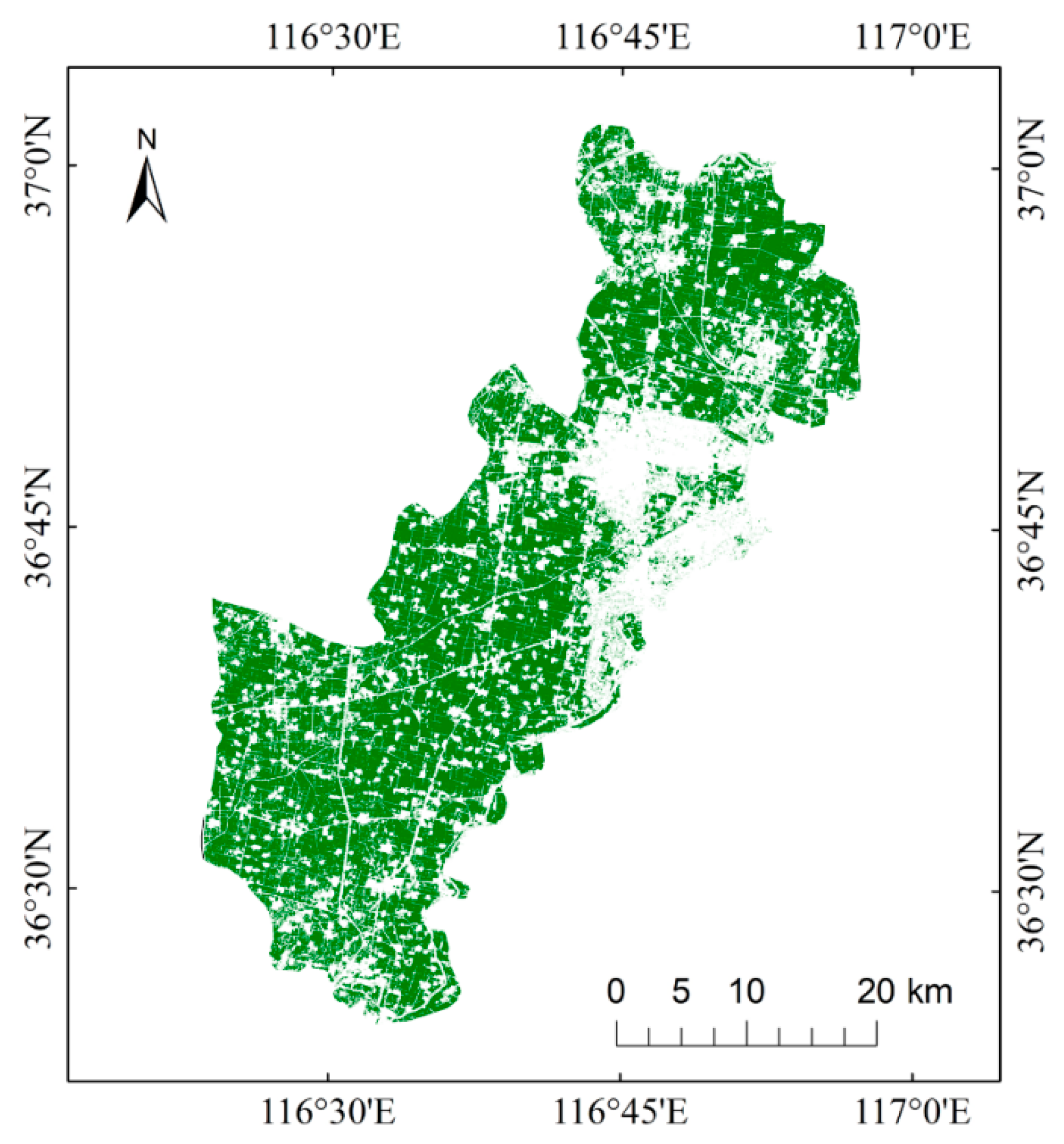

| Parameters | Spectral Range (nm) | Spatial Resolution (m) | Swath Width (km) | |
|---|---|---|---|---|
| WFV | B1 (Blue) | 450–520 | 16 | 800 |
| B2 (Green) | 520–590 | |||
| B3 (Red) | 630–690 | |||
| B4 (Near Infrared) | 770–890 | |||
| B5 (Red-edge 1) | 690–730 | |||
| B6 (Red-edge 2) | 730–770 | |||
| B7 (Purple) | 400–450 | |||
| B8 (Yellow) | 590–630 |
| Schemes | Operating Bands |
|---|---|
| S1 | B1, B2, B3, B4 |
| S2 | B1, B2, B3, B4, B5 |
| S3 | B1, B2, B3, B4, B6 |
| S4 | B1, B2, B3, B4, B5, B6 |
| S5 | B1, B2, B3, B4, B5, B6, B7, B8 |
| S1 | S2 | S3 | S4 | S5 | ||||||
|---|---|---|---|---|---|---|---|---|---|---|
| JM | TD | JM | TD | JM | TD | JM | TD | JM | TD | |
| Building | 2.00 | 2.00 | 2.00 | 2.00 | 2.00 | 2.00 | 2.00 | 2.00 | 2.00 | 2.00 |
| Woodland | 1.43 | 1.81 | 1.67 | 1.95 | 1.77 | 1.95 | 1.83 | 1.98 | 1.86 | 1.99 |
| Other plants | 1.32 | 1.43 | 1.80 | 1.97 | 1.71 | 1.97 | 1.87 | 1.99 | 1.89 | 2.00 |
| Water | 2.00 | 2.00 | 2.00 | 2.00 | 2.00 | 2.00 | 2.00 | 2.00 | 2.00 | 2.00 |
| Wasteland | 1.87 | 2.00 | 1.99 | 2.00 | 1.97 | 2.00 | 1.99 | 2.00 | 2.00 | 2.00 |
| Road | 1.85 | 2.00 | 1.91 | 2.00 | 1.88 | 2.00 | 1.92 | 2.00 | 1.95 | 2.00 |
| S1 | S2 | S3 | S4 | S5 | ||
|---|---|---|---|---|---|---|
| SVM | OA | 84.05% | 90.02% | 89.80% | 91.10% | 91.53% |
| KC | 0.80 | 0.87 | 0.87 | 0.88 | 0.89 | |
| RF | OA | 85.57% | 93.24% | 87.38% | 93.15% | 94.18% |
| KC | 0.82 | 0.91 | 0.84 | 0.91 | 0.92 |
| Building | Woodland | Other Plants | Water | Wasteland | Road | Maize | ||
|---|---|---|---|---|---|---|---|---|
| S1 | Building | 97.50 | 0 | 0 | 0.95 | 16.91 | 12.17 | 0 |
| Woodland | 0.16 | 84.45 | 0.31 | 0.08 | 3.76 | 0.58 | 3.91 | |
| Other plants | 0 | 0 | 59.31 | 0.01 | 0 | 0 | 12.27 | |
| Water | 0 | 7.88 | 0.09 | 97.49 | 1.36 | 0 | 0 | |
| Wasteland | 1.61 | 1.17 | 21.58 | 0.08 | 64.65 | 2.63 | 0.17 | |
| Road | 0.73 | 4.46 | 0.09 | 1.20 | 11.78 | 83.78 | 1.29 | |
| Maize | 0 | 2.04 | 18.62 | 0.18 | 1.53 | 0.85 | 82.36 | |
| S2 | Building | 97.69 | 0 | 0 | 0.83 | 15.28 | 12.48 | 0 |
| Woodland | 0.18 | 90.29 | 1.50 | 0.07 | 3.22 | 0 | 1.47 | |
| Other plants | 0 | 0 | 72.07 | 0.01 | 0 | 0 | 0.08 | |
| Water | 0 | 0.73 | 0 | 97.46 | 1.53 | 0 | 0 | |
| Wasteland | 1.55 | 1.27 | 18.18 | 0.07 | 71.63 | 2.05 | 0.01 | |
| Road | 0.58 | 6.17 | 1.77 | 1.37 | 6.11 | 84.09 | 0.86 | |
| Maize | 0 | 1.53 | 6.49 | 0.18 | 2.24 | 1.38 | 97.57 | |
| S3 | Building | 97.81 | 0 | 0 | 1.05 | 20.73 | 12.48 | 0 |
| Woodland | 0.05 | 84.59 | 0.44 | 0.13 | 2.62 | 0 | 2.02 | |
| Other plants | 0 | 0.05 | 59.8 | 0 | 0 | 0 | 9.8 | |
| Water | 0 | 8.14 | 0 | 97.44 | 0.93 | 0 | 0 | |
| Wasteland | 1.55 | 1.06 | 21.76 | 0.07 | 65.19 | 2.63 | 0.12 | |
| Road | 0.6 | 4.74 | 0.31 | 1.14 | 9.00 | 83.42 | 1.17 | |
| Maize | 0 | 1.41 | 17.7 | 0.17 | 1.53 | 1.47 | 86.89 | |
| S4 | Building | 97.97 | 0 | 0 | 1.03 | 20.68 | 12.39 | 0 |
| Woodland | 0.05 | 88.41 | 0.71 | 0.07 | 2.89 | 0.04 | 1.33 | |
| Other plants | 0 | 0.02 | 77.14 | 0.01 | 0 | 0 | 0.29 | |
| Water | 0 | 2.86 | 0.04 | 97.46 | 1.96 | 0 | 0 | |
| Wasteland | 1.55 | 1.31 | 18.09 | 0.07 | 68.63 | 2.32 | 0.02 | |
| Road | 0.42 | 5.94 | 0.44 | 1.17 | 3.76 | 83.91 | 0.81 | |
| Maize | 0.02 | 1.46 | 3.57 | 0.18 | 2.07 | 1.34 | 97.55 | |
| S5 | Building | 97.42 | 0 | 0 | 0 | 14.72 | 2.81 | 0 |
| Woodland | 0.07 | 87.00 | 0.18 | 0 | 2.08 | 0 | 1.00 | |
| Other plants | 0 | 0.02 | 70.93 | 0 | 0 | 0 | 0.20 | |
| Water | 0 | 10.34 | 0.18 | 100 | 3.12 | 0 | 0 | |
| Wasteland | 1.47 | 1.17 | 19.35 | 0 | 75.97 | 2.08 | 0 | |
| Road | 1.04 | 0.67 | 0.57 | 0 | 1.59 | 94.89 | 0.52 | |
| Maize | 0 | 0.81 | 8.80 | 0 | 2.52 | 0.23 | 98.28 |
| No. | Contrast of Bands Different Combination | p-Value |
|---|---|---|
| 1 | S2 to S1 | 0.0156 |
| 2 | S3 to S1 | 0.0781 |
| 3 | S4 to S1 | 0.0156 |
| 4 | S5 to S1 | 0.0156 |
| 5 | S3 to S2 | 0.0234 |
| 6 | S4 to S2 | 0.6875 |
| 7 | S5 to S2 | 0.3828 |
| 8 | S4 to S3 | 0.0078 |
| 9 | S5 to S3 | 0.0156 |
| 10 | S5 to S4 | 0.3828 |
| No. | Area (m × m) | No. of Plants | Weight of Straw (kg) | Density of Straw (t/km2) |
|---|---|---|---|---|
| 1 | 10 × 5 | 336 | 40.24 | 804.8 |
| 2 | 10 × 5 | 308 | 35.63 | 712.6 |
| 3 | 10 × 5 | 322 | 37.46 | 749.2 |
| Average | 755.53 | |||
Publisher’s Note: MDPI stays neutral with regard to jurisdictional claims in published maps and institutional affiliations. |
© 2021 by the authors. Licensee MDPI, Basel, Switzerland. This article is an open access article distributed under the terms and conditions of the Creative Commons Attribution (CC BY) license (https://creativecommons.org/licenses/by/4.0/).
Share and Cite
Mou, H.; Li, H.; Zhou, Y.; Dong, R. Response of Different Band Combinations in Gaofen-6 WFV for Estimating of Regional Maize Straw Resources Based on Random Forest Classification. Sustainability 2021, 13, 4603. https://doi.org/10.3390/su13094603
Mou H, Li H, Zhou Y, Dong R. Response of Different Band Combinations in Gaofen-6 WFV for Estimating of Regional Maize Straw Resources Based on Random Forest Classification. Sustainability. 2021; 13(9):4603. https://doi.org/10.3390/su13094603
Chicago/Turabian StyleMou, Huawei, Huan Li, Yuguang Zhou, and Renjie Dong. 2021. "Response of Different Band Combinations in Gaofen-6 WFV for Estimating of Regional Maize Straw Resources Based on Random Forest Classification" Sustainability 13, no. 9: 4603. https://doi.org/10.3390/su13094603
APA StyleMou, H., Li, H., Zhou, Y., & Dong, R. (2021). Response of Different Band Combinations in Gaofen-6 WFV for Estimating of Regional Maize Straw Resources Based on Random Forest Classification. Sustainability, 13(9), 4603. https://doi.org/10.3390/su13094603








